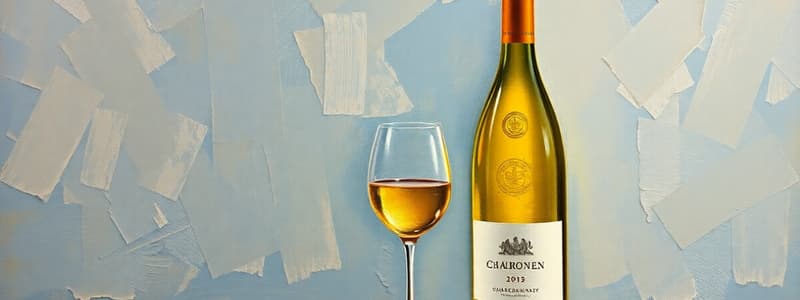Podcast
Questions and Answers
Which characteristic primarily distinguishes Chablis from other Chardonnay wines?
Which characteristic primarily distinguishes Chablis from other Chardonnay wines?
- Higher residual sugar content.
- Its typically higher acidity and distinct minerality derived from the Kimmeridgian soil. (correct)
- Use of oak aging, resulting in a buttery flavor profile.
- Dominant flavors of tropical fruit.
If a customer prefers a crisp, dry white wine with herbaceous notes, which of the following would be the most suitable recommendation?
If a customer prefers a crisp, dry white wine with herbaceous notes, which of the following would be the most suitable recommendation?
- A heavily oaked Chardonnay
- Chardonnay
- Sauvignon Blanc (correct)
- Chablis
Which of the following white wines is typically associated with flavors of citrus, green apple, and flint?
Which of the following white wines is typically associated with flavors of citrus, green apple, and flint?
- Oaked Chardonnay
- Chardonnay
- Sauvignon Blanc
- Chablis (correct)
A wine taster notes 'unoaked' characteristics, which of these wines are they most likely referring to?
A wine taster notes 'unoaked' characteristics, which of these wines are they most likely referring to?
Compared to a Chardonnay from California, a Chablis from France will typically exhibit:
Compared to a Chardonnay from California, a Chablis from France will typically exhibit:
A customer requests a white wine to pair with oysters. Which option would be the best choice?
A customer requests a white wine to pair with oysters. Which option would be the best choice?
Which wine is most likely to exhibit aromas of grapefruit and passionfruit?
Which wine is most likely to exhibit aromas of grapefruit and passionfruit?
Which of the following represents a key difference between Chardonnay and Sauvignon Blanc in terms of flavor profile?
Which of the following represents a key difference between Chardonnay and Sauvignon Blanc in terms of flavor profile?
If a wine label indicates '0.75l', what information is being conveyed?
If a wine label indicates '0.75l', what information is being conveyed?
When considering food pairings, which general guideline is most accurate for the listed wines?
When considering food pairings, which general guideline is most accurate for the listed wines?
Flashcards
Chablis
Chablis
A dry, still white wine produced in the Chablis district of Burgundy, France, known for its green-gold color and crisp acidity.
Chardonnay
Chardonnay
A versatile white grape variety known for producing wines with a range of flavors from crisp and mineral to rich and oaky, depending on the climate and winemaking techniques.
Sauvignon Blanc
Sauvignon Blanc
A green-skinned grape variety that produces a dry, crisp white wine with herbaceous aromas, such as grass, bell pepper, and gooseberry.
Study Notes
- White wines
- Category of wines characterized by their light color, ranging from straw-yellow to gold
- Typically made from green-skinned grapes, but can be produced from red-skinned grapes if the skins are removed immediately after crushing
- Fermented without skin contact, which distinguishes them from red wines
- Wide range of styles, from crisp and dry to rich and sweet
Chablis 0.75l
- A dry, white wine from the Chablis region of Burgundy, France
- Made exclusively from Chardonnay grapes
- Known for its high acidity and flinty, mineral notes
- Typically unoaked, which allows the pure expression of the Chardonnay grape and the terroir to shine through
- Often exhibits aromas of green apple, citrus, and white flowers
- Best served chilled, around 8-10°C (46-50°F)
- Pairs well with seafood, especially oysters, as well as light salads and goat cheese
- The "0.75l" denotes the standard bottle size of 750ml
- The Kimmeridgian soil in Chablis, a unique type of limestone rich in marine fossils, contributes significantly to the wine's distinctive minerality
Chardonnay 0.75l
- One of the world's most popular and widely planted grape varieties
- Exhibits a wide range of flavors depending on the climate and winemaking techniques employed
- Can be produced in a variety of styles, from lean and crisp to rich and buttery
- Cool-climate Chardonnay often displays flavors of green apple, pear, and citrus
- Warmer-climate Chardonnay can exhibit flavors of tropical fruit, such as pineapple and mango
- Oak aging can impart flavors of vanilla, butterscotch, and toast
- Malolactic fermentation gives it a buttery characteristic
- The "0.75l" denotes the standard bottle size of 750ml
- Pairs well with a variety of foods, including chicken, fish, and creamy pasta dishes
- Examples include:
- Burgundy Chardonnay: Known for elegance and complexity
- Californian Chardonnay: Often bolder with oak influence
- Unoaked Chardonnay: Highlights the grape's natural flavors
Sauvignon Blanc 0.75l
- A dry, white wine known for its herbaceous and aromatic qualities
- Originates from the Loire Valley region of France
- Widely planted in various regions, including New Zealand, South Africa, and California
- Characterized by high acidity and vibrant flavors
- Often exhibits aromas of grapefruit, passionfruit, and freshly cut grass
- The "0.75l" denotes the standard bottle size of 750ml
- Typically unoaked, which preserves its crispness and aromatic intensity
- Best served chilled, around 8-10°C (46-50°F)
- Pairs well with salads, seafood, and goat cheese
- Examples include:
- Loire Valley Sauvignon Blanc (e.g., Sancerre, Pouilly-Fumé): Known for minerality and subtle herbaceous notes
- New Zealand Sauvignon Blanc: Known for intense grapefruit and passionfruit aromas
Studying That Suits You
Use AI to generate personalized quizzes and flashcards to suit your learning preferences.

